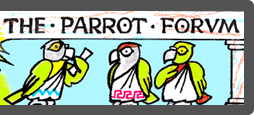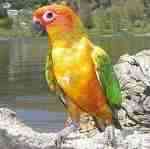


Winter Sunlight Solutions?
25 posts • Page 3 of 3 • 1, 2, 3
Re: Winter Sunlight Solutions?
Chickens get cataracts and/or conjunctivitis from exposure to some artificial lights. Parrots are not chickens, but they are birds. Too much of a "good" thing, is not. Again, I try to go natural when at all possible.
Roz
There are in nature neither rewards nor punishments — there are only consequences. Robert G. Ingersoll
There are in nature neither rewards nor punishments — there are only consequences. Robert G. Ingersoll
-

patdbunny - Amazon
- Gender:

- Posts: 579
- Location: east san diego county, CA
- Number of Birds Owned: 30
- Types of Birds Owned: sun conure, parrotlet, cockatiel, african greys, eclectus, sun conures, jenday conures, indian ringnecks, parrotlets, bourkes.
- Flight: No
Re: Winter Sunlight Solutions?
Sorry Michael about the the offtopic thing, thats why i stopped, just had to explain to entranced or else everyone will get the wrong impression. I did mention that i didnt know what spectrum a bird needs and yes if theres no uv on a bioptron i know that but didnt know birds need that the most. I just think its better then no light at all (not for UV but possibly to keep the bird healthier or anything like that until he is able to go outside) I suppose for everything else it might help but i might post a new topic about it seperately.
With that said I heard that windows block a large amount of sunlight. lorenzo sits by the window for most of the morning even though theres no sun outside and i dont know if he gets much out of it. have to wait until summer or even spring to put him outside.
however id like to know how much sunlight a bird would need once outside in direct sunlight? an hour a day? a few hours a day etc? for them to get the maximum amount of sunlight?
if a bird has to be in all winter long can the color blindness only last until hes back in the sunlight?
How about using one of those outdoor heaters which restaurants use and sit with the bird outside in a carrier. this if it helps to get the minimum exposure. through the warmer days in winter.

With that said I heard that windows block a large amount of sunlight. lorenzo sits by the window for most of the morning even though theres no sun outside and i dont know if he gets much out of it. have to wait until summer or even spring to put him outside.
however id like to know how much sunlight a bird would need once outside in direct sunlight? an hour a day? a few hours a day etc? for them to get the maximum amount of sunlight?
if a bird has to be in all winter long can the color blindness only last until hes back in the sunlight?
How about using one of those outdoor heaters which restaurants use and sit with the bird outside in a carrier. this if it helps to get the minimum exposure. through the warmer days in winter.
-

idlepirate - Conure
- Gender:

- Posts: 211
- Location: UK
- Number of Birds Owned: 1
- Types of Birds Owned: Blue Throated Conure
- Flight: Yes
Re: Winter Sunlight Solutions?
The "color blindness" is not a change in the bird, it is just because that color light is not bouncing around in the environment. Think of it more as if all the lighting in your house was from a red bulb. As soon as you reintroduced a white bulb, the colors would look "normal" again. This is not nearly as drastic an effect though. I'd guess it is analogous to wearing those tinted sunglasses for driving that are supposed to increase contrast. I don't like them because they distort colors and make greens look browner, but it is fairly subtle.
Window glass blocks virtually all the UV and quite a bit of the infrared. You can have good fun with an infrared camera that operates in the 8-12 micron window (one of the few atmospheric windows that lets any of the IR from the sun through -- sunlight received at the ground is not truly full spectrum either, plenty of wavelengths are blocked by the atmosphere. ) You can hold a piece of glass up in front of you, and it will appear totally opaque, blocking your image completely in the camera view. Then you can take a piece of black plastic trash bag, and the camera will "see" right through it. (Note to women, do not wear synthetic blouses when demoing the IR camera, it WILL see through your shirt if you happen to chose the wrong one!). Face painting with a piece of ice is another fun party trick. So sitting in front of a window definitely only exposes you to a fraction of what being out in the sun exposes you to.
Bottom line is that what we see with our eyes is really a tiny part of the electromagnetic spectrum. And it is all fundamentally the same thing, what makes different forms of light important biologically is how materials absorb and reflect them. In essence, either the light is deflected away from the body entirely or it is absorbed -- absorbed light essentially transfers the energy it was carrying to the biological material, and that energy can do any number of things either beneficial or destructive. Lasers do what they do because they can concentrate that energy transfer in way normal light does not.
I actually am having trouble finding an article that really explains what the chemistry/biology of the UV--uropygial gland interaction is. Can anyone point me at a fairly technical description?
Window glass blocks virtually all the UV and quite a bit of the infrared. You can have good fun with an infrared camera that operates in the 8-12 micron window (one of the few atmospheric windows that lets any of the IR from the sun through -- sunlight received at the ground is not truly full spectrum either, plenty of wavelengths are blocked by the atmosphere. ) You can hold a piece of glass up in front of you, and it will appear totally opaque, blocking your image completely in the camera view. Then you can take a piece of black plastic trash bag, and the camera will "see" right through it. (Note to women, do not wear synthetic blouses when demoing the IR camera, it WILL see through your shirt if you happen to chose the wrong one!). Face painting with a piece of ice is another fun party trick. So sitting in front of a window definitely only exposes you to a fraction of what being out in the sun exposes you to.
Bottom line is that what we see with our eyes is really a tiny part of the electromagnetic spectrum. And it is all fundamentally the same thing, what makes different forms of light important biologically is how materials absorb and reflect them. In essence, either the light is deflected away from the body entirely or it is absorbed -- absorbed light essentially transfers the energy it was carrying to the biological material, and that energy can do any number of things either beneficial or destructive. Lasers do what they do because they can concentrate that energy transfer in way normal light does not.
I actually am having trouble finding an article that really explains what the chemistry/biology of the UV--uropygial gland interaction is. Can anyone point me at a fairly technical description?
Scooter 
Death Valley Scotty
Death Valley Scotty
-

entrancedbymyGCC - Cockatoo
- Gender:

- Posts: 2106
- Location: Southern California aka LALA land
- Number of Birds Owned: 2
- Types of Birds Owned: Green Cheek Conure
(Un)Cape Parrot - Flight: No
Re: Winter Sunlight Solutions?
Very informative thread! It is really useful I should say.
- nayam
- Parakeet
- Gender:

- Posts: 1
- Number of Birds Owned: 1
- Types of Birds Owned: Parrotlets
- Flight: Yes
Re: Winter Sunlight Solutions?
Nayam, this thread is very old and it has never been updated but I have a few comments on the questions asked.
1. Yes, there is an alternative to glass that allows all light to go through: polycarbonate made without UV filters.
2. It's not that the uropygial gland needs UV to produce the precursor to Vit D3 (the preen oil would still be produced without any UV light). What happens is the uropygial gland produces preen oil which the bird uses to preen his feathers. This oil covering the feathers is chemically affected by the UV light in the sunshine and becomes the precursor to vit D3 which is, in turn, ingested by the bird as it preens. But there are birds that don't have an uropygial gland and these birds produce the precursor from good cholesterol on their exposed skin.
3. Full spectrum is the only artificial light we have available that remotely resembles sun light and the only one that should be used with parrots (NEVER a UV light!) but it also needs to have the right specifications: CRI 93+ and KTemp 5000.
4. Tropical or semi-tropical birds cannot 'acclimate' to low temperatures. They can withstand them for a short while but long exposure would end up shortening their lifespans.
5. There is no need whatsoever to actually expose a bird, any bird, to very low temperatures so it can produce its own Vit D3, a good supplement does the trick without the hassle and potential danger.
6. Red light will not make a plucker stop pulling its own feathers.
1. Yes, there is an alternative to glass that allows all light to go through: polycarbonate made without UV filters.
2. It's not that the uropygial gland needs UV to produce the precursor to Vit D3 (the preen oil would still be produced without any UV light). What happens is the uropygial gland produces preen oil which the bird uses to preen his feathers. This oil covering the feathers is chemically affected by the UV light in the sunshine and becomes the precursor to vit D3 which is, in turn, ingested by the bird as it preens. But there are birds that don't have an uropygial gland and these birds produce the precursor from good cholesterol on their exposed skin.
3. Full spectrum is the only artificial light we have available that remotely resembles sun light and the only one that should be used with parrots (NEVER a UV light!) but it also needs to have the right specifications: CRI 93+ and KTemp 5000.
4. Tropical or semi-tropical birds cannot 'acclimate' to low temperatures. They can withstand them for a short while but long exposure would end up shortening their lifespans.
5. There is no need whatsoever to actually expose a bird, any bird, to very low temperatures so it can produce its own Vit D3, a good supplement does the trick without the hassle and potential danger.
6. Red light will not make a plucker stop pulling its own feathers.
- Pajarita
- Norwegian Blue
- Gender:

- Posts: 18705
- Location: NW Pa
- Number of Birds Owned: 30
- Types of Birds Owned: RoseBreasted too, CAG, DoubleYellowHead Amazon, BlueFront Amazon, YellowNape Amazon, Senegal, African Redbelly, Quaker, Sun Conure, Nanday, BlackCap Caique, WhiteBelly Caique, PeachFace lovebird, budgies,
- Flight: Yes
25 posts • Page 3 of 3 • 1, 2, 3
Who is online
Users browsing this forum: Google Adsense [Bot] and 12 guests
